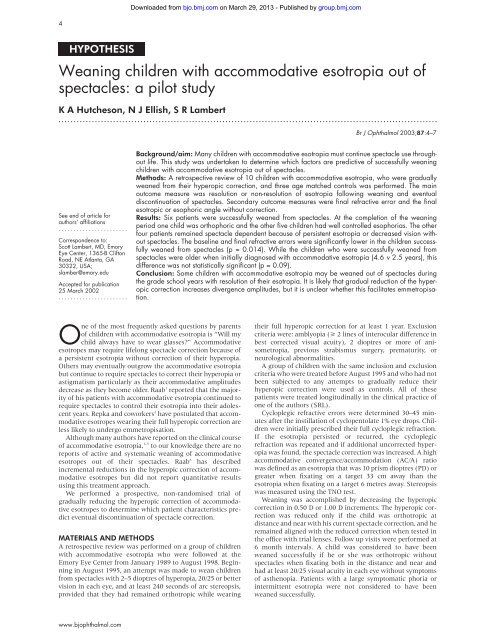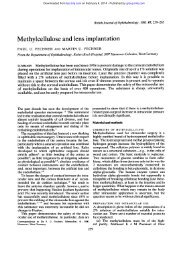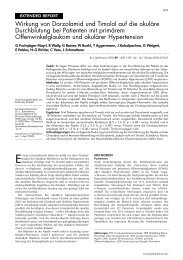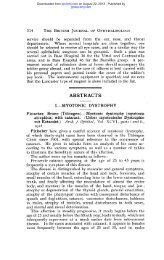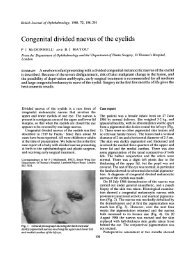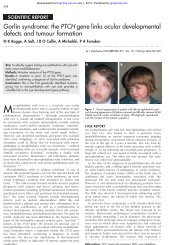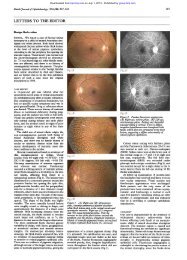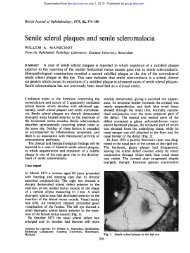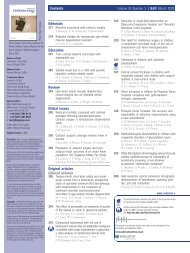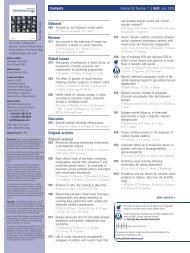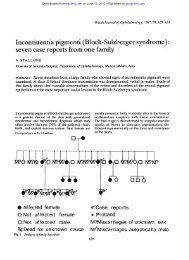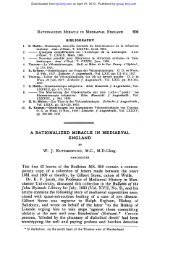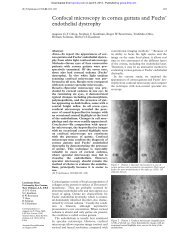Weaning children with accommodative esotropia out of spectacles: a ...
Weaning children with accommodative esotropia out of spectacles: a ...
Weaning children with accommodative esotropia out of spectacles: a ...
You also want an ePaper? Increase the reach of your titles
YUMPU automatically turns print PDFs into web optimized ePapers that Google loves.
4<br />
HYPOTHESIS<br />
<strong>Weaning</strong> <strong>children</strong> <strong>with</strong> <strong>accommodative</strong> <strong>esotropia</strong> <strong>out</strong> <strong>of</strong><br />
<strong>spectacles</strong>: a pilot study<br />
K A Hutcheson, N J Ellish, S R Lambert<br />
.............................................................................................................................<br />
See end <strong>of</strong> article for<br />
authors’ affiliations<br />
.......................<br />
Correspondence to:<br />
Scott Lambert, MD, Emory<br />
Eye Center, 1365-B Clifton<br />
Road, NE Atlanta, GA<br />
30322, USA;<br />
slamber@emory.edu<br />
Accepted for publication<br />
25 March 2002<br />
.......................<br />
O ne<br />
Br J Ophthalmol 2003;87:4–7<br />
Background/aim: Many <strong>children</strong> <strong>with</strong> <strong>accommodative</strong> <strong>esotropia</strong> must continue spectacle use through<strong>out</strong><br />
life. This study was undertaken to determine which factors are predictive <strong>of</strong> successfully weaning<br />
<strong>children</strong> <strong>with</strong> <strong>accommodative</strong> <strong>esotropia</strong> <strong>out</strong> <strong>of</strong> <strong>spectacles</strong>.<br />
Methods: A retrospective review <strong>of</strong> 10 <strong>children</strong> <strong>with</strong> <strong>accommodative</strong> <strong>esotropia</strong>, who were gradually<br />
weaned from their hyperopic correction, and three age matched controls was performed. The main<br />
<strong>out</strong>come measure was resolution or non-resolution <strong>of</strong> <strong>esotropia</strong> following weaning and eventual<br />
discontinuation <strong>of</strong> <strong>spectacles</strong>. Secondary <strong>out</strong>come measures were final refractive error and the final<br />
esotropic or esophoric angle <strong>with</strong><strong>out</strong> correction.<br />
Results: Six patients were successfully weaned from <strong>spectacles</strong>. At the completion <strong>of</strong> the weaning<br />
period one child was orthophoric and the other five <strong>children</strong> had well controlled esophorias. The other<br />
four patients remained spectacle dependent because <strong>of</strong> persistent <strong>esotropia</strong> or decreased vision <strong>with</strong><strong>out</strong><br />
<strong>spectacles</strong>. The baseline and final refractive errors were significantly lower in the <strong>children</strong> successfully<br />
weaned from <strong>spectacles</strong> (p = 0.014). While the <strong>children</strong> who were successfully weaned from<br />
<strong>spectacles</strong> were older when initially diagnosed <strong>with</strong> <strong>accommodative</strong> <strong>esotropia</strong> (4.6 v 2.5 years), this<br />
difference was not statistically significant (p = 0.09).<br />
Conclusion: Some <strong>children</strong> <strong>with</strong> <strong>accommodative</strong> <strong>esotropia</strong> may be weaned <strong>out</strong> <strong>of</strong> <strong>spectacles</strong> during<br />
the grade school years <strong>with</strong> resolution <strong>of</strong> their <strong>esotropia</strong>. It is likely that gradual reduction <strong>of</strong> the hyperopic<br />
correction increases divergence amplitudes, but it is unclear whether this facilitates emmetropisation.<br />
<strong>of</strong> the most frequently asked questions by parents<br />
<strong>of</strong> <strong>children</strong> <strong>with</strong> <strong>accommodative</strong> <strong>esotropia</strong> is “Will my<br />
child always have to wear glasses?” Accommodative<br />
esotropes may require lifelong spectacle correction because <strong>of</strong><br />
a persistent <strong>esotropia</strong> <strong>with</strong><strong>out</strong> correction <strong>of</strong> their hyperopia.<br />
Others may eventually <strong>out</strong>grow the <strong>accommodative</strong> <strong>esotropia</strong><br />
but continue to require <strong>spectacles</strong> to correct their hyperopia or<br />
astigmatism particularly as their <strong>accommodative</strong> amplitudes<br />
decrease as they become older. Raab 1 reported that the majority<br />
<strong>of</strong> his patients <strong>with</strong> <strong>accommodative</strong> <strong>esotropia</strong> continued to<br />
require <strong>spectacles</strong> to control their <strong>esotropia</strong> into their adolescent<br />
years. Repka and coworkers 2 have postulated that <strong>accommodative</strong><br />
esotropes wearing their full hyperopic correction are<br />
less likely to undergo emmetropisation.<br />
Although many authors have reported on the clinical course<br />
<strong>of</strong> <strong>accommodative</strong> <strong>esotropia</strong>, 1–5 to our knowledge there are no<br />
reports <strong>of</strong> active and systematic weaning <strong>of</strong> <strong>accommodative</strong><br />
esotropes <strong>out</strong> <strong>of</strong> their <strong>spectacles</strong>. Raab 6 has described<br />
incremental reductions in the hyperopic correction <strong>of</strong> <strong>accommodative</strong><br />
esotropes but did not report quantitative results<br />
using this treatment approach.<br />
We performed a prospective, non-randomised trial <strong>of</strong><br />
gradually reducing the hyperopic correction <strong>of</strong> <strong>accommodative</strong><br />
esotropes to determine which patient characteristics predict<br />
eventual discontinuation <strong>of</strong> spectacle correction.<br />
MATERIALS AND METHODS<br />
A retrospective review was performed on a group <strong>of</strong> <strong>children</strong><br />
<strong>with</strong> <strong>accommodative</strong> <strong>esotropia</strong> who were followed at the<br />
Emory Eye Center from January 1989 to August 1998. Beginning<br />
in August 1995, an attempt was made to wean <strong>children</strong><br />
from <strong>spectacles</strong> <strong>with</strong> 2–5 dioptres <strong>of</strong> hyperopia, 20/25 or better<br />
vision in each eye, and at least 240 seconds <strong>of</strong> arc stereopsis,<br />
provided that they had remained orthotropic while wearing<br />
www.bjophthalmol.com<br />
Downloaded from<br />
bjo.bmj.com on March 29, 2013 - Published by group.bmj.com<br />
their full hyperopic correction for at least 1 year. Exclusion<br />
criteria were: amblyopia (> 2 lines <strong>of</strong> interocular difference in<br />
best corrected visual acuity), 2 dioptres or more <strong>of</strong> anisometropia,<br />
previous strabismus surgery, prematurity, or<br />
neurological abnormalities.<br />
A group <strong>of</strong> <strong>children</strong> <strong>with</strong> the same inclusion and exclusion<br />
criteria who were treated before August 1995 and who had not<br />
been subjected to any attempts to gradually reduce their<br />
hyperopic correction were used as controls. All <strong>of</strong> these<br />
patients were treated longitudinally in the clinical practice <strong>of</strong><br />
one <strong>of</strong> the authors (SRL).<br />
Cycloplegic refractive errors were determined 30–45 minutes<br />
after the instillation <strong>of</strong> cyclopentolate 1% eye drops. Children<br />
were initially prescribed their full cycloplegic refraction.<br />
If the <strong>esotropia</strong> persisted or recurred, the cycloplegic<br />
refraction was repeated and if additional uncorrected hyperopia<br />
was found, the spectacle correction was increased. A high<br />
<strong>accommodative</strong> convergence/accommodation (AC/A) ratio<br />
was defined as an <strong>esotropia</strong> that was 10 prism dioptres (PD) or<br />
greater when fixating on a target 33 cm away than the<br />
<strong>esotropia</strong> when fixating on a target 6 metres away. Stereopsis<br />
was measured using the TNO test.<br />
<strong>Weaning</strong> was accomplished by decreasing the hyperopic<br />
correction in 0.50 D or 1.00 D increments. The hyperopic correction<br />
was reduced only if the child was orthotropic at<br />
distance and near <strong>with</strong> his current spectacle correction, and he<br />
remained aligned <strong>with</strong> the reduced correction when tested in<br />
the <strong>of</strong>fice <strong>with</strong> trial lenses. Follow up visits were performed at<br />
6 month intervals. A child was considered to have been<br />
weaned successfully if he or she was orthotropic <strong>with</strong><strong>out</strong><br />
<strong>spectacles</strong> when fixating both in the distance and near and<br />
had at least 20/25 visual acuity in each eye <strong>with</strong><strong>out</strong> symptoms<br />
<strong>of</strong> asthenopia. Patients <strong>with</strong> a large symptomatic phoria or<br />
intermittent <strong>esotropia</strong> were not considered to have been<br />
weaned successfully.
Downloaded from<br />
bjo.bmj.com on March 29, 2013 - Published by group.bmj.com<br />
<strong>Weaning</strong> <strong>children</strong> <strong>with</strong> <strong>accommodative</strong> <strong>esotropia</strong> <strong>out</strong> <strong>of</strong> <strong>spectacles</strong> 5<br />
Figure 1 Age spectacle wear initiated for study (group 1,<br />
<strong>spectacles</strong> discontinued; group 2, <strong>spectacles</strong> still worn) and control<br />
patients compared to <strong>accommodative</strong> esotropes reported by Raab 1<br />
and Repka. 2<br />
Figure 2 Initial refractive error for study (group 1, <strong>spectacles</strong><br />
discontinued; group 2, <strong>spectacles</strong> still worn) and control patients<br />
compared to <strong>accommodative</strong> esotropes reported by Raab 1 and<br />
Repka. 2<br />
Because our data are non-normative, and given the small<br />
sample size, results are reported as medians rather than<br />
means. Statistical comparisons were performed using the<br />
Wilcoxon rank sum test.<br />
RESULTS<br />
Group 1 (n=6)<br />
Six <strong>children</strong> who were subjected to weaning were able to discontinue<br />
spectacle wear by the end <strong>of</strong> the study period. These<br />
<strong>children</strong> had a median age <strong>of</strong> 4.6 years (range 2.5–6.0 years)<br />
(Fig 1) at the time spectacle wear was initiated and baseline<br />
hyperopia <strong>of</strong> +2.25 D (range +1.75 to +2.80 D) (Fig 2). The<br />
baseline esotropic angle was 22.5 PD (range 10–25 PD). Five <strong>of</strong><br />
the six <strong>children</strong> had a normal baseline AC/A ratio. They had an<br />
initial increase in their hyperopic refractive error <strong>of</strong> +1.00 D,<br />
and a subsequent mean decrease <strong>of</strong> −1.70 D over a median<br />
period <strong>of</strong> 3.75 years while wearing <strong>spectacles</strong> (Fig 3). The peak<br />
refractive error was + 3.25 D and the final refractive error at<br />
the time <strong>of</strong> spectacle discontinuation was +1.56 D (range 0.0<br />
D to +3.06 D). The rate <strong>of</strong> decline in hyperopia was −0.51<br />
D/year. Median astigmatism averaged over the study period<br />
was +0.18 D, and the median peak astigmatism was +0.20 D.<br />
The one child <strong>with</strong> a high AC/A ratio wore bifocals for 1 year<br />
until the AC/A ratio normalised. Final median stereoacuity<br />
was 45 seconds <strong>of</strong> arc (range 30–120 seconds). The final<br />
median strabismic angle, uncorrected, was 13 PD <strong>of</strong> esophoria<br />
(range 0–20 PD). One child was orthophoric and the other five<br />
<strong>children</strong> had excellent control <strong>of</strong> their esophorias. The final<br />
AC/A ratio remained unchanged in four <strong>children</strong>, increased in<br />
one child, and decreased in one child. <strong>Weaning</strong> was<br />
commenced at a median age <strong>of</strong> 6.3 years and completed by a<br />
median <strong>of</strong> 9.0 years (Fig 4). These <strong>children</strong> had been <strong>out</strong> <strong>of</strong><br />
glasses for a median <strong>of</strong> 1.6 years at the end <strong>of</strong> the follow up<br />
period.<br />
Figure 3 Change in hyperopia in group 1 patients.<br />
Figure 4 Age weaning initiated and completed for group 1 and 2<br />
patients.<br />
Figure 5 Changes in hyperopia in group 2 patients.<br />
Group 2 (n=4)<br />
The <strong>children</strong> who were still dependent upon <strong>spectacles</strong> at the<br />
completion <strong>of</strong> the study period were a median age <strong>of</strong> 2.5 years<br />
at the time they were initially treated for their <strong>accommodative</strong><br />
<strong>esotropia</strong> <strong>with</strong> <strong>spectacles</strong> (range 2.0–4.5 years) (Fig 1). Their<br />
baseline hyperopia was +4.50 D (range +3.00 to +5.00 D)<br />
(Fig 2). Their baseline esotropic angle was 30 PD (range 20–40<br />
PD). All <strong>of</strong> the <strong>children</strong> had a normal baseline AC/A ratio. Their<br />
hyperopia peaked at +5.55 D and by the completion <strong>of</strong> the<br />
study had declined to a median <strong>of</strong> +5.05 D (Fig 5). The rate <strong>of</strong><br />
decline in hyperopia from the peak to the final value was −0.07<br />
D/year. The final spectacle prescription worn was a median <strong>of</strong><br />
−1.52 D less than their full cycloplegic refraction. The median<br />
final astigmatic refractive error was +1.84 D, and the peak<br />
astigmatism for any child at any visit was +2.75 D. The<br />
median final stereoacuity was 45 seconds <strong>of</strong> arc (range 15–60<br />
seconds <strong>of</strong> arc). The final esotropic angle, <strong>with</strong><strong>out</strong> correction,<br />
was 17 PD (range 10–25 PD). One child had an intermittent<br />
<strong>esotropia</strong>; the other three <strong>children</strong> continued to have a<br />
constant <strong>esotropia</strong> <strong>with</strong><strong>out</strong> <strong>spectacles</strong>. The final AC/A ratio<br />
was relatively unchanged in three <strong>children</strong> and decreased in<br />
one child. <strong>Weaning</strong> was commenced at a median age <strong>of</strong> 9.3<br />
years (Fig 4). At the completion <strong>of</strong> the study, these <strong>children</strong><br />
had worn glasses for a median <strong>of</strong> 6.3 years.<br />
Control group (n=3)<br />
The three control <strong>children</strong> were initially treated for their<br />
<strong>accommodative</strong> <strong>esotropia</strong> <strong>with</strong> <strong>spectacles</strong> at a median age <strong>of</strong><br />
4.5 years (Fig 1). Their baseline refractive error was +3.25 D<br />
(range +2.00 to +3.67 D) (Fig 2). Their baseline <strong>esotropia</strong> was<br />
30 PD (range 20–35 PD). After a follow up period <strong>of</strong> 5 years<br />
www.bjophthalmol.com
6 Hutcheson, Ellish, Lambert<br />
Figure 6 The annual rate <strong>of</strong> refractive change in study (group 1,<br />
<strong>spectacles</strong> discontinued; group 2, <strong>spectacles</strong> still worn) and control<br />
patients compared to <strong>accommodative</strong> esotropes reported by Raab 1<br />
and Repka. 2<br />
(range 3.5–7 years) these <strong>children</strong> had a final refractive error<br />
<strong>of</strong> +3.88 D (range +2.75 to +4.50 D). They had a slight<br />
increase in hyperopia <strong>of</strong> +0.18 D/year before age 7 years and a<br />
slight decline <strong>of</strong> –0.12 D/year after age 7 years (Fig 6). Median<br />
final stereoacuity was 40 seconds <strong>of</strong> arc (range 30–100 seconds<br />
<strong>of</strong> arc). The final esotropic angle, <strong>with</strong><strong>out</strong> correction, was 35<br />
PD (range, 30–35 PD). Over the course <strong>of</strong> the study, the<br />
median uncorrected esotropic angle increased by 5 PD.<br />
The baseline hyperopia in the <strong>children</strong> who discontinued<br />
spectacle wear (group 1) was less than the <strong>children</strong> who continued<br />
to require <strong>spectacles</strong> (group 2) (+2.25 v +4.50 D) (p =<br />
0.014). The median final refractive error was also significantly<br />
lower in group 1, compared to group 2 (+1.56 D v +5.05 D) (p<br />
= 0.014). Although the <strong>children</strong> in group 1 tended to be an<br />
older age when diagnosed <strong>with</strong> <strong>accommodative</strong> <strong>esotropia</strong> than<br />
the <strong>children</strong> in group 2 (4.6 v 2.5 years), the difference was not<br />
statistically significant (p = 0.09).<br />
Hyperopia increased steadily and rapidly before the age <strong>of</strong> 7<br />
years for the <strong>children</strong> in group 1 (+0.43 D/year), and then<br />
declined rapidly (−0.6 D/year v −1.2 D/year). The <strong>children</strong> in<br />
group 2 had a gradual increase in their hyperopia before age 7<br />
years (+0.27 D/year) and then had a slow decline after age 7<br />
years (−0.18 D/year) (Fig 6). The overall rate <strong>of</strong> decline from<br />
peak to final refraction was −0.51 D/year for the <strong>children</strong> in<br />
group 1, which was significantly faster than the overall decline<br />
<strong>of</strong> −0.07 D/year for the <strong>children</strong> in group 2 (p = 0.014).<br />
The median final astigmatic error for group 1 was +0.18 D,<br />
compared to +1.84 D for group 2 (p= 0.13). Three <strong>of</strong> the four<br />
<strong>children</strong> in group 2 had greater than +1.50 dioptres <strong>of</strong> astigmatism<br />
at the last follow up examination.<br />
DISCUSSION<br />
In this study six <strong>of</strong> 10 (60%) <strong>children</strong> <strong>with</strong> <strong>accommodative</strong><br />
<strong>esotropia</strong> were able to discontinue spectacle wear after a<br />
gradual reduction in their hyperopic correction at a median<br />
age <strong>of</strong> 9 years. In contrast, other studies have reported that<br />
only 3–24% <strong>of</strong> <strong>accommodative</strong> esotropes treated in a more<br />
conventional manner are able to discontinue spectacle wear<br />
when teenagers or adults. 3–7<br />
Accommodative esotropes may be able to discontinue spectacle<br />
use as a result <strong>of</strong> increased fusional divergence<br />
amplitudes, the loss <strong>of</strong> hyperopia, or a reduction in the synkinesis<br />
between accommodation and convergence. In our study,<br />
divergence amplitudes increased in all 10 study patients<br />
including the four patients who continued to require<br />
<strong>spectacles</strong>. By the end <strong>of</strong> the study the four patients who continued<br />
to require <strong>spectacles</strong> tolerated a mean undercorrection<br />
<strong>of</strong> their hyperopic refractive error <strong>of</strong> 1.5 D while still remaining<br />
orthotropic. The six <strong>children</strong> who successfully discontinued<br />
spectacle wear also had a reduction in their baseline<br />
hyperopia <strong>of</strong> nearly 0.75 D (+2.25 v +1.56 D) which may have<br />
www.bjophthalmol.com<br />
Downloaded from<br />
bjo.bmj.com on March 29, 2013 - Published by group.bmj.com<br />
also facilitated their discontinuation <strong>of</strong> <strong>spectacles</strong>. In contradistinction,<br />
both the control patients and the four study<br />
patients who were not able to discontinue spectacle use had an<br />
increase in their hyperopia from the baseline to the final<br />
examination (controls +3.25 to +3.88 D; study patients +4.50<br />
to +5.05 D). However, despite the increase in their hyperopic<br />
refractive error, these four study patients had a reduction in<br />
their <strong>esotropia</strong> <strong>with</strong><strong>out</strong> <strong>spectacles</strong> (35–17 PD) whereas the<br />
angle <strong>of</strong> <strong>esotropia</strong> <strong>of</strong> the control patients increased (30–35<br />
PD). This difference presumably reflects their increased divergence<br />
amplitudes <strong>of</strong> the study patients. We did not find a significant<br />
change in the ratio <strong>of</strong> accommodation to convergence<br />
among study or control patients.<br />
The study patients who were successfully weaned <strong>out</strong> <strong>of</strong><br />
<strong>spectacles</strong> demonstrated a median loss <strong>of</strong> hyperopia <strong>of</strong> 1.75 D<br />
from their peak refractive error or –0.51 D/year. In contrast,<br />
Repka 2 found only a mean decline in hyperopia <strong>of</strong> −0.12 D/year<br />
in a large cohort <strong>of</strong> <strong>accommodative</strong> esotropes 7 years <strong>of</strong> age or<br />
older (Fig 6). Similarly, Raab 1 noted a decline in hyperopia <strong>of</strong><br />
−0.18 D per year in a group <strong>of</strong> <strong>accommodative</strong> esotropes 7–13<br />
years <strong>of</strong> age. Our control patients experienced a similar rate <strong>of</strong><br />
decline in their hyperopic refractive error when 7 years <strong>of</strong> age<br />
or older (−0.12 D/year).<br />
Repka 2 has postulated that prescribing the full cycloplegic<br />
refractive correction may interfere <strong>with</strong> the emmetropisation<br />
<strong>of</strong> <strong>children</strong>’s eyes. In contrast, Ingram and coworkers 8 have<br />
speculated that an intrinsic defect in the process <strong>of</strong> emmetropisation<br />
may account for the slower loss <strong>of</strong> hyperopia in<br />
<strong>accommodative</strong> esotropes. In animal studies, optical blur has<br />
been shown to affect ocular development and<br />
emmetropisation. 9–13 In a series <strong>of</strong> experiments performed in<br />
infant rhesus monkeys, Smith and Hung 9 showed that lens<br />
induced optical defocus result in compensatory changes in<br />
axial growth that reduce the magnitude <strong>of</strong> the induced refractive<br />
error. Monkeys who wore minus lenses experienced a<br />
myopic shift arising from increased axial elongation, while<br />
monkeys wearing plus lenses became more hyperopic as a<br />
result <strong>of</strong> reduced axial elongation. These results suggest that<br />
the growing eye is highly sensitive to the effect <strong>of</strong> optical<br />
defocus and that a spectacle correction may interfere <strong>with</strong><br />
emmetropisation. Furthermore, full correction <strong>of</strong> the hyperopic<br />
refractive error may blunt emmetropisation more than<br />
wearing a partial correction. Gradually weaning the hyperopic<br />
correction may leave the eye <strong>with</strong> a hyperopic defocus, thereby<br />
stimulating axial elongation. Non-human primates have been<br />
shown to have less ability to compensate for higher levels <strong>of</strong><br />
lens induced refractive error. 11 In our study, the <strong>children</strong> who<br />
continued to require glasses were <strong>children</strong> <strong>with</strong> higher<br />
degrees <strong>of</strong> baseline hyperopia and astigmatism. Beyond a certain<br />
limit, the eye may simply not have the drive or capability<br />
to emmetropise.<br />
CONCLUSION<br />
In this study, we observed that some <strong>accommodative</strong> esotropes<br />
successfully discontinued spectacle wear <strong>with</strong> resolution <strong>of</strong><br />
their <strong>esotropia</strong> during the grade school years. Gradually<br />
weaning <strong>children</strong> <strong>out</strong> <strong>of</strong> <strong>spectacles</strong> may increase the proportion<br />
<strong>of</strong> patients who are able discontinue spectacle wear<br />
and it may allow them to discontinue <strong>spectacles</strong> at an earlier<br />
age. Furthermore, even those patients who were not able to<br />
discontinue spectacle use had a reduction in their undercorrected<br />
angle <strong>of</strong> <strong>esotropia</strong> and were able to control their<br />
residual <strong>esotropia</strong> <strong>with</strong> a reduced hyperopic correction.<br />
Whether or not weaning from <strong>spectacles</strong>, as performed in this<br />
study, facilitates emmetropisation remains unresolved. Our<br />
pilot study included only a small number <strong>of</strong> <strong>children</strong>, and<br />
therefore the results must be interpreted <strong>with</strong> caution. We also<br />
recognise that our data suffer from selection bias since this<br />
was not a randomised study. We are also uncertain whether<br />
binocularity is a prerequisite to successfully wean <strong>children</strong>
Downloaded from<br />
bjo.bmj.com on March 29, 2013 - Published by group.bmj.com<br />
<strong>Weaning</strong> <strong>children</strong> <strong>with</strong> <strong>accommodative</strong> <strong>esotropia</strong> <strong>out</strong> <strong>of</strong> <strong>spectacles</strong> 7<br />
from <strong>spectacles</strong>. Wilson and coworkers 14 have shown that binocularity<br />
is an important factor in helping <strong>accommodative</strong><br />
esotropes maintain their ocular alignment. Since we excluded<br />
patients from the present study who lacked binocularity we<br />
could not evaluate the role <strong>of</strong> binocularity in successfully<br />
weaning <strong>accommodative</strong> esotropes <strong>out</strong> <strong>of</strong> <strong>spectacles</strong>.<br />
ACKNOWLEDGEMENTS<br />
This research was supported in part by a Research to Prevent<br />
Blindness, Inc Lew Wasserman Award (SRL) and by a Research to<br />
Prevent Blindness unrestricted departmental grant (KAH). Presented<br />
in part at the Annual Meeting <strong>of</strong> the Association for Research and<br />
Vision in Ophthalmology, Ft Lauderdale, FL, USA, May 1999.<br />
.....................<br />
Authors’ affiliations<br />
K A Hutcheson, N J Ellish, Department <strong>of</strong> Ophthalmology, University <strong>of</strong><br />
Maryland School <strong>of</strong> Medicine, Baltimore, MD, USA<br />
S R Lambert, Emory Eye Center, Emory University, Atlanta, GA, USA<br />
REFERENCES<br />
1 Raab EL, Spierer A. Persisting <strong>accommodative</strong> <strong>esotropia</strong>. Arch<br />
Ophthalmol 1986;104:1777–9.<br />
2 Repka MX, Wellish K, Wisnicki HJ, et al. Changes in the refractive error<br />
<strong>of</strong> 94 spectacle-treated patients <strong>with</strong> acquired <strong>accommodative</strong> <strong>esotropia</strong>.<br />
Binoc Vis 1989;4:5–21.<br />
New BJO online submission and review system<br />
3 Swan KC. Accommodative <strong>esotropia</strong> long range follow-up.<br />
Ophthalmology 1983;90:1141–5.<br />
4 Taylor RH, Armitage IM, Burke JP. Fully <strong>accommodative</strong> <strong>esotropia</strong> in<br />
adolescence. Br Orthopt J 1995;52:25–8.<br />
5 Rutstein RP, Marxh-Tootle W. Clinical course <strong>of</strong> <strong>accommodative</strong><br />
<strong>esotropia</strong>. Optom Vis Sci 1998;75:97–102.<br />
6 Raab E. Etiologic factors in <strong>accommodative</strong> esodeviation. Trans Am<br />
Ophthalmol Soc 1982;80:657–94.<br />
7 Kobuta N, Akatsu S. Long-term follow-up <strong>of</strong> refractive <strong>accommodative</strong><br />
<strong>esotropia</strong>. In: Campos EC, ed. Strabismus and ocular motility disorders.<br />
London: Macmillan Press, 1990:315–18.<br />
8 Ingram RM, Gill LE, Lambert TW. Effect <strong>of</strong> <strong>spectacles</strong> on changes <strong>of</strong><br />
spherical hypermetropia in infants who did, and did not, have<br />
strabismus. Br J Ophthalmol 2000;84:324–6.<br />
9 Smith EL, Hung LF. The role <strong>of</strong> optical defocus in regulating refractive<br />
development in infant monkeys. Vis Res 1999;39:1415–35.<br />
10 Goss DA, Wickham MG. Retinal-image mediated ocular growth as a<br />
mechanism for juvenile onset myopia and for emmetropization. Doc<br />
Ophthalmol 1995;90:341–75.<br />
11 Smith EL, Hung LF, Harwerth RS. Effects <strong>of</strong> optically induced blur on the<br />
refractive status <strong>of</strong> young monkeys. Vis Res 1994;34:293–301.<br />
12 Fujikado T, Kawasaki Y, Suzuki A, et al. Retinal function <strong>with</strong><br />
lens-induced myopia compared <strong>with</strong> form-deprivation myopia in chicks.<br />
Graefes Arch Clin Exp Ophthalmol 1997;235:320–4.<br />
13 Troilo D, Wallman J. The regulation <strong>of</strong> eye growth and refractive<br />
state: an experimental study <strong>of</strong> emmetropization. Vis Res<br />
1991;31:1237–50.<br />
14 Wilson ME, Bluestein EC, Parks MM. Binocularity in <strong>accommodative</strong><br />
<strong>esotropia</strong>. J Pediatr Ophthalmol Strabismus 1993;30:233–6.<br />
The Editors <strong>of</strong> British Journal <strong>of</strong> Opthalmology are pleased to inform authors and reviewers<br />
<strong>of</strong> its new online submission and review system. Bench>Press is a fully integrated electronic<br />
system which uses the internet to allow rapid and efficient submission <strong>of</strong><br />
manuscripts, as well as the entire peer review process to be conducted online.<br />
Authors can submit their manuscript in any standard word processing s<strong>of</strong>tware. Graphic<br />
formats acceptable are: .jpg, .tiff, .gif, and eps. (Nb. Multipage PowerPoint presentations<br />
are NOT acceptable.) Text and graphic files are automatically converted to PDF for ease<br />
<strong>of</strong> distribution and reviewing purposes. Authors are asked to approve their submission<br />
before it formally enters the reviewing process.<br />
To access the system click on “SUBMIT YOUR MANUSCRIPT HERE” on the BJO<br />
homepage: http://www.bjopthalmol.com/, or you can access Bench>Press directly at<br />
http://submit-bjo.bmjjournals.com/.<br />
We are very excited <strong>with</strong> this new development, it really is simple to use and should be a<br />
big improvement on the current peer review process. Full instructions can be found on<br />
Bench>Press and BJO online. Please contact Natalie Davies, Project Manager,<br />
ndavies@bmjgroup.com for further information.<br />
Pre-register<br />
We would be grateful if all British Journal <strong>of</strong> Opthalmology authors and reviewers<br />
pre-registered <strong>with</strong> the system. This will give you the opportunity to update your contact<br />
and expertise data, allowing us to provide you <strong>with</strong> a more efficient service.<br />
Instructions For Registering<br />
1. Enter http://submit-bjo.bmjjournals.com<br />
2. Click on “Create a New Account” in the upper left hand side <strong>of</strong> the Bench>Press<br />
homepage.<br />
3. Enter your email address in the space provided.<br />
4. Choose a password for yourself and enter it in the spaces provided.<br />
5. Complete the question <strong>of</strong> your choice to be used in the event you cannot remember your<br />
password at a later time.<br />
6. Click on the “Save” button at the bottom <strong>of</strong> the screen.<br />
7. Check the email account you registered under. An email will be sent to you <strong>with</strong> a verification<br />
number and URL.<br />
8. Once you receive this verification number, click on the URL hyperlink and enter the verification<br />
number in the relevant field. This is for security reasons and to check that your account is<br />
not being used fraudulently.<br />
9. Enter/amend your contact information, and update your expertise data.<br />
10. Please note: You only need to create a new account once. If you submit to another<br />
BMJ Publishing Group journal you can use the same email address and password<br />
www.bjophthalmol.com
References<br />
Email alerting<br />
service<br />
Topic<br />
Collections<br />
Notes<br />
<strong>Weaning</strong> <strong>children</strong> <strong>with</strong> <strong>accommodative</strong><br />
<strong>esotropia</strong> <strong>out</strong> <strong>of</strong> <strong>spectacles</strong>: a pilot study<br />
K A Hutcheson, N J Ellish and S R Lambert<br />
Br J Ophthalmol 2003 87: 4-7<br />
doi: 10.1136/bjo.87.1.4<br />
Updated information and services can be found at:<br />
http://bjo.bmj.com/content/87/1/4.full.html<br />
These include:<br />
To request permissions go to:<br />
http://group.bmj.com/group/rights-licensing/permissions<br />
To order reprints go to:<br />
http://journals.bmj.com/cgi/reprintform<br />
To subscribe to BMJ go to:<br />
http://group.bmj.com/subscribe/<br />
Downloaded from<br />
bjo.bmj.com on March 29, 2013 - Published by group.bmj.com<br />
This article cites 12 articles, 1 <strong>of</strong> which can be accessed free at:<br />
http://bjo.bmj.com/content/87/1/4.full.html#ref-list-1<br />
Article cited in:<br />
http://bjo.bmj.com/content/87/1/4.full.html#related-urls<br />
Receive free email alerts when new articles cite this article. Sign up in the<br />
box at the top right corner <strong>of</strong> the online article.<br />
Articles on similar topics can be found in the following collections<br />
Muscles (203 articles)<br />
Neurology (1109 articles)<br />
Optic nerve (588 articles)<br />
Optics and refraction (413 articles)


